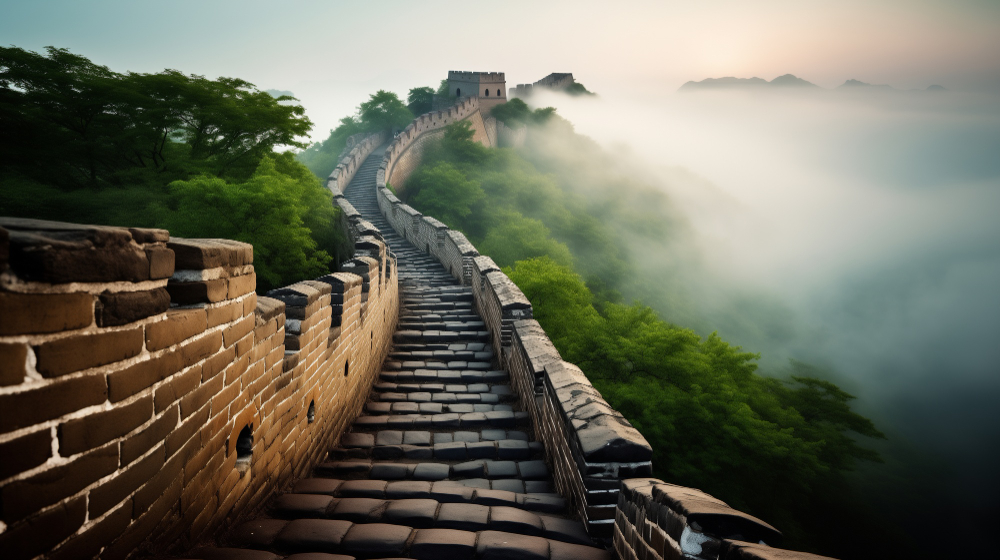The Magnificent Great Wall and the Qin Dynasty’s Lasting Impact
Perched majestically across the northern borders of China, the Great Wall is not just a wonder of the world but also a monumental testament to the sheer will and advanced engineering of ancient civilizations. Originating from the Qin Dynasty (221–206 BC), under the forceful leadership of Emperor Qin Shi Huang, this colossal structure was initially erected to shield the nascent unified Chinese state from northern invasions and to solidify the emperor’s iron grip on the various warring factions. Through this exploration, we delve into the intricate origins, purposeful construction, strategic utility, and the undying legacy of the Great Wall, emphasizing its significance during the Qin era.
The Origins of the Great Wall: A Brief Historical Context
Long before the ambitious projects of the Qin Dynasty, fragmented walls stood guard over the fragmented states of pre-imperial China. These were primarily defensive structures, meant to repel invasions from nomadic tribes and rival states. With Qin Shi Huang’s unprecedented unification of China, the strategic need to consolidate these walls into a singular, formidable barrier against the northern nomads became apparent. This section unravels the historical layers leading up to the monumental decision to erect the Great Wall, underscoring the emperor’s motivations behind this gargantuan task aimed at both defense and the assertion of newly centralized authority.
Construction Techniques: How the Qin Built the Wall
The construction of the Great Wall during the Qin Dynasty is a story of exceptional engineering prowess and relentless human endeavor. Utilizing local resources, the wall was primarily built from tamped earth, with layers of wood and stone reinforcements where available. Mobilizing a vast workforce comprised of soldiers, commoners, convicts, and even intellectuals out of favor with the emperor, the Qin Dynasty’s approach to building the wall was as ruthless as it was efficient. This segment highlights the innovative construction techniques, logistical organization, and the human cost of constructing the Great Wall, providing insights into the ancient methods that laid the foundation of this enduring symbol of Chinese resilience.

The Purpose of the Great Wall: Defense, Control, and Beyond
The Great Wall transcended its apparent role as a mere defensive fortification. Strategically, it was a multifaceted asset serving various administrative and economic functions. It acted as a bulwark against invasions, a controlled gateway for Silk Road trade, and a tool for regulating migration and managing the empire’s northern frontier. Symbolically, it represented the emperor’s absolute power and divine mandate. This discussion explores the multifunctional uses of the Wall under Qin rule, illustrating its impact on the socio-economic and political landscapes of ancient China.
The Great Wall’s Decline and Restoration Over Time
Following the demise of the Qin Dynasty, the Great Wall entered a cyclical phase of decline and restoration, mirroring the ebb and flow of China’s historical fortunes. Subsequent dynasties like the Han, Sui, and notably the Ming invested in repairing, reinforcing, and extending the Wall, each leaving their mark on its vast stretch. This section examines the ongoing struggle to maintain the integrity of the Wall through centuries of natural wear and human conflict, alongside modern efforts to preserve this iconic structure as a UNESCO World Heritage Site and a global symbol of Chinese cultural endurance.
Tracing the Legacy of the Great Wall Today
Today, the Great Wall stands as a bridge between the ancient and the modern, attracting millions of visitors from around the globe each year. Its image is deeply ingrained in Chinese national identity and cultural pride. This final section reflects on the contemporary relevance of the Great Wall, not just as a historical relic but as a beacon of inspiration for modern architectural and infrastructural ambitions worldwide. The enduring lessons of the Qin Dynasty’s monumental project continue to resonate, underscoring themes of unity, defense, and human achievement.
The Enduring Legacy of the Qin Dynasty and the Great Wall
As we conclude our journey along the rugged paths of the Great Wall, the enduring legacy of the Qin Dynasty remains vividly etched along its battlements. This structure is more than just stone and earth; it is a narrative of human endeavor, strategic foresight, and unyielding determination. The Great Wall not only encapsulates the history of a civilization reaching for greatness but also stands as a testament to the timeless pursuit of legacy and continuity amidst the shifting sands of time. As it snakes across the landscapes of China, the Great Wall continues to inspire awe and wonder, preserving the memory of its ancient architects and the emperor who envisioned its creation.

Comment0